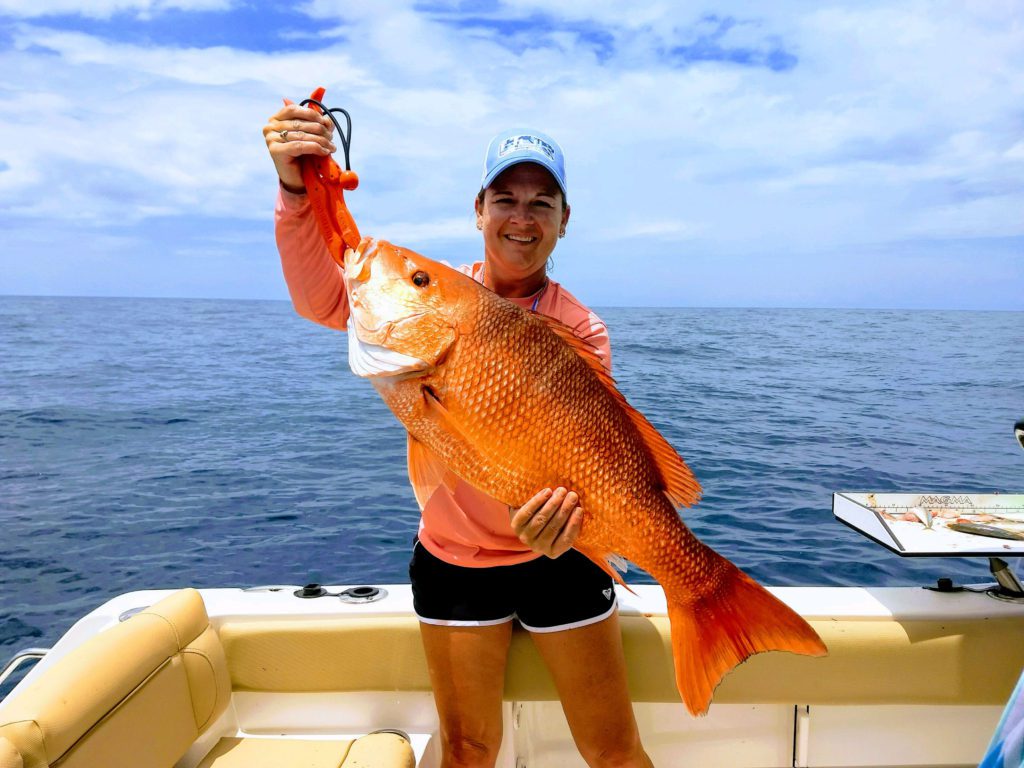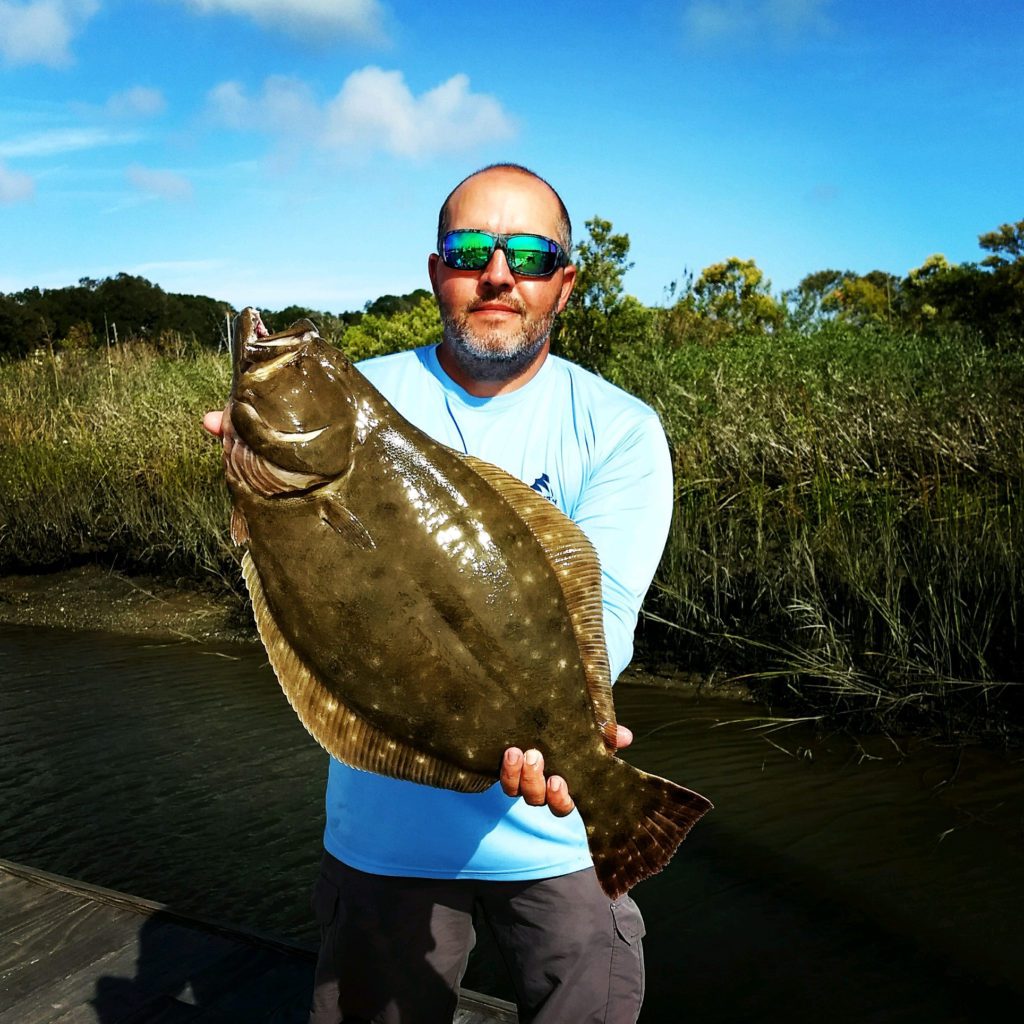Southport – December 14, 2017
Annette, of Dutchman’s Creek Bait and Tackle, reports that anglers working the surf zone have found solid numbers of whiting. Fresh cut shrimp and Fishbites, specifically bloodworm and shrimp, on a bottom rig have been doing the trick. Anglers tossing cut mullet have also picked up a bonus red drum or two.
Inshore, speckled trout have been the hot ticket. Right now they are everywhere in the ICW working their way into the creeks. Hands down, MirrOlure MR17s in the electric chicken color have been everyone’s go-to lure.
Red drum are being found in the same areas as the trout. They will also take a MirrOlure, but the reds more often find it hard to turn down a soft plastic on a 3/16 or 1/4 oz. jig head. However, when you can get live shrimp and mud minnows, they’ve been producing more numbers of fish than any artificial.
Black drum are the other main species you’ll find with the trout and reds. The black drum tend to prefer cut or live shrimp fished on the bottom using a Carolina rig. Docks and marsh banks are a good place to start looking for these tasty fish.
Nearshore, there are still some schools of citation red drum along the beaches.
Looking forward, the inshore bite should stay consistent through the winter. Trout, redfish, and black drum will stick around and continue to feed on the same baits as they are feeding on now. Live mud minnows will replace live shrimp as the shrimp get harder to find. Fishing mud minnows under float rigs can tempt some of these cold fish to feed, as will slowly working a MirrOlure MR17.
Spots around Davis Canal and up into the feeder creeks of the ICW will hold the majority of the inshore fish for the next couple months.

Angela Sykes, of Riegelwood, NC, with a 32” American red snapper caught using a frozen cigar minnow 33 miles offshore of Southport.
Mark, of Angry Pelican Charters, reports that the king mackerel bite has been outstanding. Finding warmer water in the 20-30 mile range has been the key to finding good numbers of quality fish. Over the next couple months, the Horseshoe and Frying Pan Tower areas will continue to be productive. Look for significant temperature breaks in these areas and the bait that concentrates there. Jigging cigar minnows and slow trolling are both options, but dead baits behind Pirate plugs or Blue Water Candy shovels will get the job done as well. To cover more ground, try pulling Drone spoons on deep diving planers.
Large false albacore and the occasional blackfin tuna will be feeding in the same areas. Using the same tactics for the kings will prove effective on these fish.
Bottom fishing in depths greater than 75-80’+ should be excellent over the next couple of months. Using live or cut baits and fishing close to structure, ledges, wrecks, and live bottoms will do the trick.
Giant bluefin tuna are feeding off our coast again. No need to look further than a few miles off the beach to find these hungry beasts. The mild weather we’ve been having is forecasted to last into January, and these fish should stick around as long as this weather lasts.
Nearshore, the mouth of the Cape Fear River will provide anglers with outstanding whiting fishing. There are plenty of good-sized fish around this time of year. Long shank small hooks with fresh cut bait on double drop bottom rigs are all you need for a cooler full.
Once the water drops into the 50’s, the black sea bass will start to congregate better on nearshore structure, such as the Lighthouse Rock area. Squid and a variety of cut baits on standard bottom rigs will get the job done. Jigging with a diamond jig or Stingsilver will produce, too.
Robert, of Reelin’ Pelican Charters, reports that bottom fishing in the area is awesome right now. Grouper, grunts, and beeliners are holding tight to rocks and structure around the 30 mile mark, and large “knot head” black sea bass in the 4-5 lb. range are holding around the Tower area. Whole or cut squid and cut cigar minnows on double loop bottom rigs are working great.
Wahoo are out in the Gulf Stream in good numbers. Ilanders rigged with ballyhoo and black/purple Fathom lures on a planer are the top producers. Watching your finder and pulling rigs at the same depth where you see bait is going to be key in finding success.
Mahi and blackfin tuna are in schools and looking for baits alongside the wahoo. Smaller feathers rigged with ballyhoo will work best.
Speckled trout and redfish are holding in the creeks off the ICW. Artificial baits, such as soft plastics on 1/4 or 3/16 oz. jig heads, are working great. As winter progresses, hard suspending baits and lighter jig heads fished slowly will be helpful in getting bites. The cold water slows the movement of the trout, and they won’t have energy to chase a bait moving too fast.
Sheepshead are taking fiddler crabs fished tight to hard bottom and structure. Look for areas of fast current to produce some of the bigger fish.

Brad Ricker with a 9.26 lb. flounder caught using a 3” Gulp shrimp on a 1/2 oz. jig head.
Ryan, of Fugitive Charters, reports that the king mackerel have still been the main target offshore, with big numbers of fish mostly in the 25 mile range. Kings of all sizes, from the good eating “smoker” size up to 45 lbs., are being caught.
Bottom fishing has also been productive. Grouper, snapper, and triggerfish are feeding feverishly on cut cigar minnows. Look for good bottom in the 30-35 mile range for these fish.
Inshore, speckled trout have been on fire. Fish have been found from the inlet up into the creeks, and they are quick to jump on live shrimp or shrimp imitation lures.
Redfish and flounder are mixed in with the trout, and they are also ready to pick up a live shrimp or a Gulp soft plastic.
Through the next couple of months, the inshore bite will be focused on trout and redfish.
Offshore, the king bite will provide action during good weather windows. The kings will push a little further with the falling water temps, usually out to the Tower area. Generally, 35-40 miles is a good starting point as you search for water in the 67-69 degree range.
